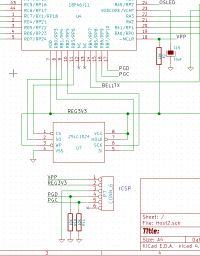
- Joined
- Jul 4, 2009
- Messages
- 16,468
- Helped
- 5,156
- Reputation
- 10,343
- Reaction score
- 5,199
- Trophy points
- 1,393
- Location
- Aberdyfi, West Wales, UK
- Activity points
- 139,357
Data sheet page 369:
The only other reference to a series resistor mentions 1K but is specific to instances where MCLR is external and the supply rise time is long. It's purpose there is to prevent excess current from the C in the RC delay from discharging rapidly into the pin if VDD drops rapidly.
100 Ohms in series with VPP probably won't stop it programming but note the current to the pin during a programming cycle can be as much as 10mA.
Brian.
nothing there about needing a series resistor between programming voltage and VPP. The VPP pin should have a pull-up resistor to VDD for normal operation but the current through it is only normal CMOS input leakage of a few nA at most.2: Voltage spikes below VSS at the MCLR/V PP/RE3 pin, inducing currents greater than 80 mA, may cause
latch-up. Thus, a series resistor of 50-100 should be used when applying a “low” level to the
MCLR/VPP/RE3 pin, rather than pulling this pin directly to VSS.
The only other reference to a series resistor mentions 1K but is specific to instances where MCLR is external and the supply rise time is long. It's purpose there is to prevent excess current from the C in the RC delay from discharging rapidly into the pin if VDD drops rapidly.
100 Ohms in series with VPP probably won't stop it programming but note the current to the pin during a programming cycle can be as much as 10mA.
Brian.

